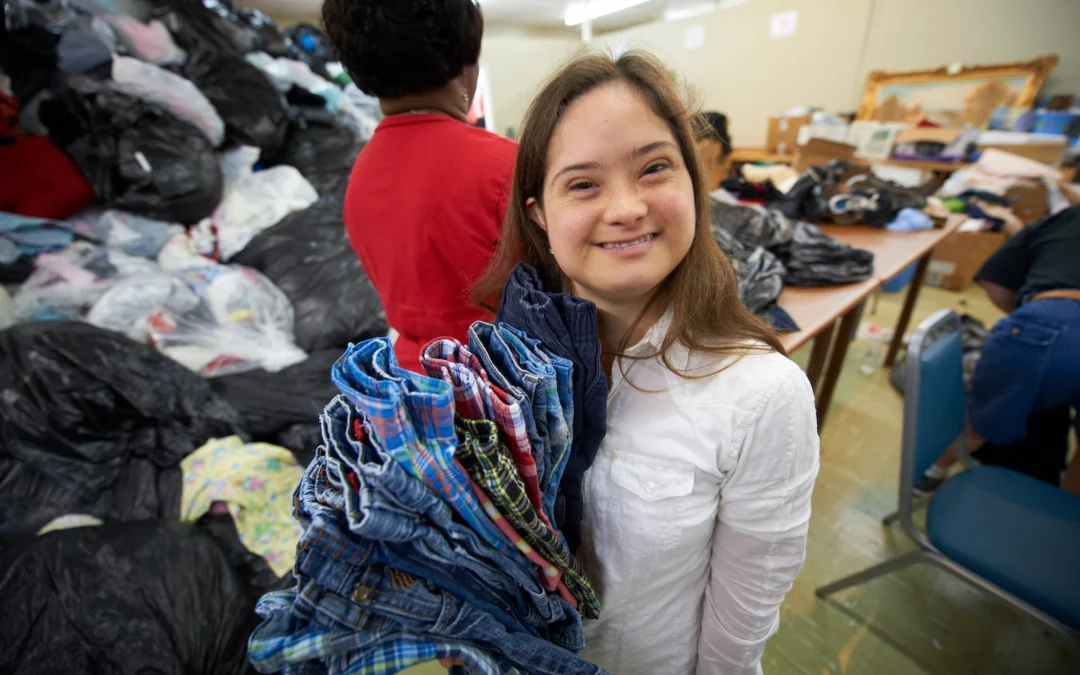When every hanger is occupied and closets are overflowing, the idea of simply donating the surplus to charity is an appealing solution. Giving to others makes us feel good, and donating clothes is often a quick, no-questions-asked way of ridding ourselves of garments we no longer want or need. Equally important, however, is making certain that the clothing donation we give consists of items that other people just like us would actually want or need. To ensure that a donation will actually add resources to a charity rather than strip resources away, givers can make a genuine effort to donate responsibly by following some simple guidelines on how to donate clothes.
Choosing What To Donate
With decluttering and practical minimalism trending, many organizational experts suggest sorting through closets and drawers and creating three piles—one to keep, one to donate and one to throw away. According to Earth.org, however, thanks to fast fashion trends, “The average US consumer throws away 81.5 pounds of clothes every year.” That figure equates to 85 percent of all textiles ending up in landfills yearly.
To manage our fashion waste more responsibly, perhaps a better trio of labels for our piles might consist of one to keep, one to donate and one to repurpose.
- What To Keep—According to California Closets, most of us wear just 20 percent of the clothing we own. The other 80 percent just hangs or sits and slowly goes out of style. If you’re not sure whether to keep something, ask three simple questions. Have I worn it recently? Does it still fit me well? Is it still in style? A classic that you feel good wearing regularly is a keeper.
- What To Donate—Within the 80 percent of our wardrobe that we don’t wear are clothing mistakes that are unflattering, ill-fitting, dated or simply no longer our style. In fact, many of us have pieces that we’ll never wear, tags intact. The clothing doesn’t have anything wrong with it, but it was a wrong choice for our body type or lifestyle. If clothing is in good condition and part of the 80 percent, it’s a perfect candidate for donation.
- What To Repurpose—Many of us keep clothing that is no longer fit to wear. It may be the linen blouse that soaked up a Sharpie stain the first time we wore it or a comfy sweater that is slowly unraveling in multiple places. If an article of clothing has a flaw that is difficult or impossible to fix, it needs a new purpose.
Conditioning Clothing Donations
Customers at charity and resale shops are careful about what they will purchase. Meanwhile, those same stores typically have few to no resources for cleaning or repairing clothing donations. Ensuring that the clothing you donate is clean and in good condition is a very real and necessary part of donating clothing responsibly.
- Launder all clothing to rid it of issues like stale household odors or perfumes, shoulder dust or discolorations from hanging long term, or pet hair on hems or cuffs, for example. If articles are dry clean-only, have them cleaned, and leave the dry-cleaning tag on.
- Iron wrinkled items. Many articles of clothing go unworn simply because they must be ironed, but wrinkled clothing doesn’t display or sell well.
- Secure or replace buttons and fasteners that are loose or missing. Customers may refuse to buy clothing lacking fasteners—especially if they’re hard to match. A needle and thread offer quick fixes. Many quality brands include extra buttons either with the tag or stitched along a seam, so an easy replacement may be possible.
- Check zippers and hook-and-loop closures for smooth operation. Zippers may need to be cleaned, lubed or have stray threads cleared. For hook-and-loop closures, remove lint buildup.
- Repair open seams or loose ornamentation. Repair stitching that has opened along seams to prevent further damage.
- Untangle fringe ornamentation and string pulls.
- Clean shoes. Leather shoes may benefit from an application of leather cleaner or polish. If shoes are washable, be sure to remove the laces and wash both shoes and laces. It is also important to note that one shoe without the mate is not a suitable donation.
Don’t be surprised if you find yourself reconsidering your donation. If that happens, consider it a good thing. You can give knowing that your donated items are still useful and will benefit the receiving organization.
Repurposing Items Too Far Gone
Clothing donation dealbreakers include issues like stains that won’t come out, fabric tears and pinpoint holes, broken zippers, split seams torn at the seam line, strong odors, and scorch marks or burns, for example. Items like undergarments, socks or other personal items may not be eligible for donation either. However, worn clothing items may be able to be repurposed as textile donations.
- Stretchy cottons make great shop rags or household cleaning cloths.
- Quilters may be able to use woven cottons as quilting squares.
- Some fabrics may be suitable for crafting everything from stuffed dolls to snuffle mats.
- Buttons and fasteners from items can be reused or donated for reuse.
Many community-based service groups and organizations recycle textiles in any number of ways. Reach out locally to discover your options.
Preserving and Packing Donations
We donate hoping that someone else will like our contribution enough to buy it. However, donations must survive sorting and pricing to reach the sales floor. A big part of ensuring that happens is to pack items so that they are readily identifiable, undamaged and complete.
- If something is a multi-piece set or has accessories, fasten pieces together or place tops and bottoms or pairs of shoes together in their own small bag so that they won’t become separated or lost during the sorting process.
- Fold items neatly, and organize clothing with like items to make sorting easy. Place delicate items at the top of the box rather than the bottom.
- Keep the donation bag or box of clothing for clothing only. Mixing clothing with other household goods can result in damages.
- Use a strong bag or box able to handle the size and weight of your donation. Torn bags or flimsy boxes can put contents at risk.
- Label items of value to prevent misidentification. You may want to pack specialty items like formal gowns or business suits by themselves.
- Drop off your donation within the organization’s designated donation acceptance hours.
The best feeling is dropping off your donation knowing that you’re giving something that is useful and helps others.
Donating Responsibly to Arc of Acadiana
If your closets and drawers seem a bit full, consider taking inventory and creating your own set of piles—one to keep, one to repurpose and one to donate to Arc of Acadiana.
At Arc of Acadiana, we created our resale stores to give back to the communities we serve. Our stores employ adults with developmental disabilities who depend on Arc’s services every day, giving those individuals a safe, productive place to work and learn life skills.
As a nonprofit, we rely on donations of clothing, household goods and small furniture. If you’d like to help us in our mission, consider donating to—or shopping at—your nearest Arc of Acadiana resale store. It’s a fantastic way of giving clothing and other household items a second life while supporting someone in need in your own community.

